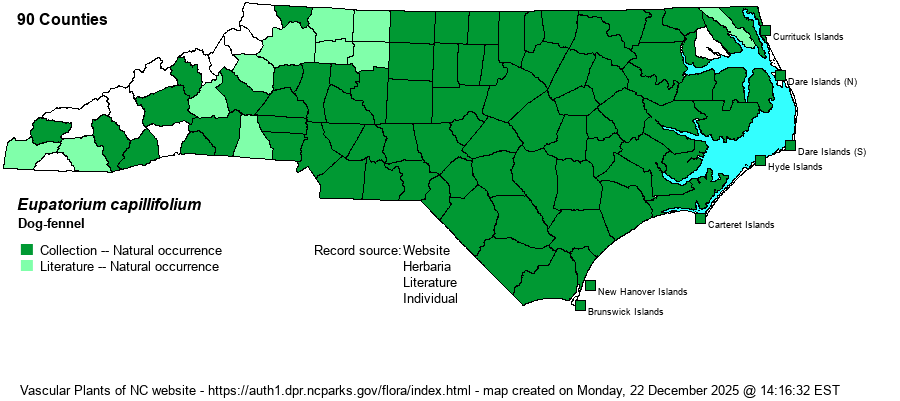| Author | (Lamarck) Small | |
| Distribution | Coastal Plain, Sandhills, and Piedmont; scarce in low Mountains. The species is clearly spreading into all corners now of the upper Piedmont and some low Mountain areas, based on recent iNaturalist photos.
CT to KY and MO, south to southern FL and TX. Bahamas. | |
| Abundance | Common to locally abundant in the Coastal Plain, Sandhills, and central-eastern Piedmont, but only infrequent in the westernmost Piedmont and Mountains -- lacking records for many counties there. | |
| Habitat | Xeric to mesic, disturbed, Longleaf Pine savannas and flatwoods, sandhills, Loblolly Pine-oak-hickory woodlands, outcrops, rocky slopes, fields, pastures, roadsides, powelines. Well adapted to disturbances, including fire. |
| Phenology | Flowering and fruiting September-November. The flowers are sweetly, but not strongly, fragrant. | |
| Identification | This and Yankeeweed (E. compositifolium) are our tallest eupatoriums (to 6.5 feet), with many strongly ascending branches bearing abundant tiny florets. Leaves are abundant and may be opposite or alternate, finely dissected into threadlike segments. Yankeeweed differs in its broader leaf segments (though still linear) at least a millimeter wide (vs. 0.5-1 mm wide). These are very familiar "weedy" species of abandoned fields, with Dog-fennel being truly abundant in many places; to many people, it seems more like a tall grass than a species in the aster family. | |
| Taxonomic Comments | None
| |
| Other Common Name(s) | Yankeeweed (typically applied to E. compositifolium) | |
| State Rank | S5 | |
| Global Rank | G5 | |
| State Status | | |
| US Status | | |
| USACE-agcp | FACU link |
| USACE-emp | FACU link |

